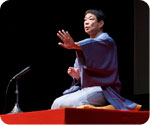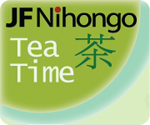

A Free E-Newsletter for Friends of Japan & Teachers of Japanese

Greetings!
There has been a great deal of astonishment and bafflement expressed from a circle of our friends since we announced the closure of our library. While I truly appreciate their sincere concerns about the fate of our organization, I would like to take this opportunity to clarify two things. First, the Japan Foundation, Los Angeles will not go anywhere! We will stay in the current location in mid-Wilshire and continue to provide free film-screenings and cultural events in our soon-to-be renovated hall as well as language classes in our cozy classroom. Second, our books will not be thrown away. We are currently making sure that our fine catalogue continues to have good public exposure at other libraries and archives. In addition, we will keep an essential portion of our language learning materials at our premise as reference for students and teachers of Japanese.
We are, and have always been, much much more than a library. A real-estate consideration may force us to downsize a little physically, but I can personally assure you that the number and quality of our activities will stay the same or even better. Above all, I am more committed than before to provide everyone with opportunities to freely cross cultural ‘walls’ in the coming four years.
Sincerely,
Hideki Hara, Director


The latest film from renowned Japanese master filmmaker Yoji Yamada, WHAT A WONDERFUL FAMILY! is a joyful and comedic tale of family life in modern Japan. Retired curmudgeon Shuzo (Isao Hashizume) lives a life of relative peace with his doting wife Tomiko (Kazuko Yoshiyuki), their two sons, daughter-in-law and two grandsons.
But when Tomiko's birthday arrives, and Shuzo has once again forgotten, she asks for a very special birthday gift: a divorce. In complete shock, Shuzo thinks this must be a joke. As it becomes clear that Tomiko is very serious, one-by-one the family members get involved.

As an artist with an academic background in the areas of Japanese traditional craft, dyeing, weaving and other handicraft techniques, Takahashi has worked with numerous artisans and has raised traditional craftwork to a whole new level with the intricate geometric patterns that are unique to her work and are created from using only lines and circles. Takahashi uses kimono as an expressive medium for her art and in doing so has put a new spin on the traditional garment.

Renowned “Rakugo” raconteur Yanagiya Sankyo, who received a 2014 Japan Foundation Award for his long-term achievements in promoting Japanese culture worldwide, will be performing a Rakugo storytelling with English subtitles! Does PowerPoint Rakugo work? Definitely! It has been tried and proven hilarious in many cities outside Japan, including ones here in the US.

August 9, 1948. Nagasaki, Japan. An aging midwife named Nobuko (Sayuri Yoshinaga) is visited by the ghost of her son Koji (Kazuya Ninomiya), whom she lost to the atomic bomb. From then on Koji visits his mother frequently to reminisce and catch up on lost time. Their biggest topic of conversation is Koji's kind-hearted fiancée Machiko (Haru Kuroki), who regularly visited Nobuko over the three years since Koji's death. Machiko and Koji both seem unable to fully accept Koji's death, but Nobuko slowly encourages them to move on.
Yoji Yamada's moving, star-studded film is a complementary response to playwright Hisashi Inoue's seminal work The Face of Jizo, about a father-daughter relationship in the aftermath of the Hiroshima bombing, and the master director's self-proclaimed attempt at making "the most important film in his life."


Come join our casual conversation café! At this popular event, you’ll enjoy conversation with native Japanese speakers while having Japanese tea & snacks! All levels are welcome!

We are pleased to announce the start of our Fiscal Year 2017-18 grant programs that we organize annually in support of Japanese-Language Education in the United States. These include the following:


There is a national teacher shortage. The JF Survey 2015 confirmed that this trend is affecting Japanese language teacher numbers as well. What can our community do about it?
First of all, what is “our community”? Who are we?
There is a vast network of passionate Japanese language teachers in the United States. Not only are there Japanese teachers’ associations across the country, but we are also connected to other organizations like Japan-America Societies, Consulates-General of Japan, Japanese chambers of commerce, and Sister City Organizations. And please remember that the Japan Foundation, Los Angeles is ready to support this community with grants and advocacy.
Together, our community has the resources to reach out and support new teachers.

For the 2016-2017 school year, we invited twelve native assistant teachers (AT) to various schools around the country as part of the Japanese Language Education Assistant Program (J-LEAP). This is the sixth year of this program where schools around the country are given the opportunity to invite an AT for up to two years with the goal of strengthening their Japanese language program. This month, we will feature the reports from the following ATs detailing their experiences at American schools.